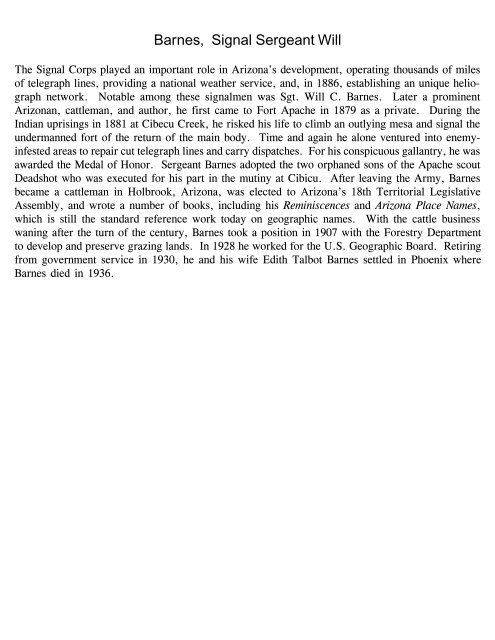Create successful ePaper yourself
Turn your PDF publications into a flip-book with our unique Google optimized e-Paper software.
Barnes, Signal Sergeant Will<br />
The Signal Corps played an important role in Arizona’s development, operating thousands of miles<br />
of telegraph lines, providing a national weather service, and, in 1886, establishing an unique heliograph<br />
network. Notable among these signalmen was Sgt. Will C. Barnes. Later a prominent<br />
Arizonan, cattleman, and author, he first came to <strong>Fort</strong> Apache in 1879 as a private. During the<br />
Indian uprisings in 1881 at Cibecu Creek, he risked his life to climb an outlying mesa and signal the<br />
undermanned fort of the return of the main body. Time and again he alone ventured into enemyinfested<br />
areas to repair cut telegraph lines and carry dispatches. For his conspicuous gallantry, he was<br />
awarded the Medal of Honor. Sergeant Barnes adopted the two orphaned sons of the Apache scout<br />
Deadshot who was executed for his part in the mutiny at Cibicu. After leaving the <strong>Army</strong>, Barnes<br />
became a cattleman in Holbrook, Arizona, was elected to Arizona’s 18th Territorial Legislative<br />
Assembly, and wrote a number of books, including his Reminiscences and Arizona Place Names,<br />
which is still the standard reference work today on geographic names. With the cattle business<br />
waning after the turn of the century, Barnes took a position in 1907 with the Forestry Department<br />
to develop and preserve grazing lands. In 1928 he worked for the U.S. Geographic Board. Retiring<br />
from government service in 1930, he and his wife Edith Talbot Barnes settled in Phoenix where<br />
Barnes died in 1936.

















